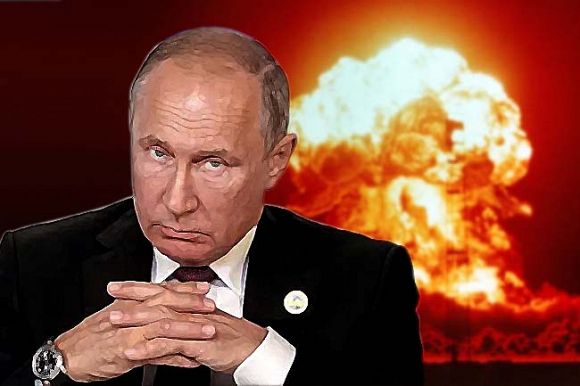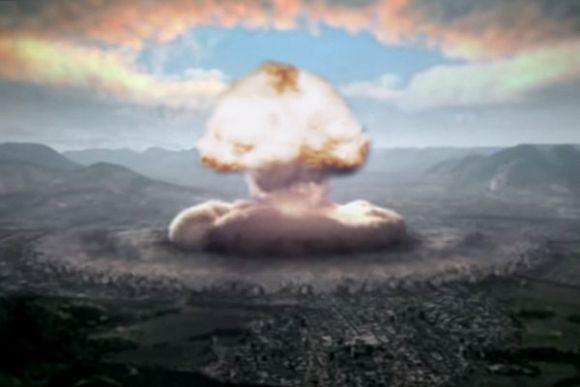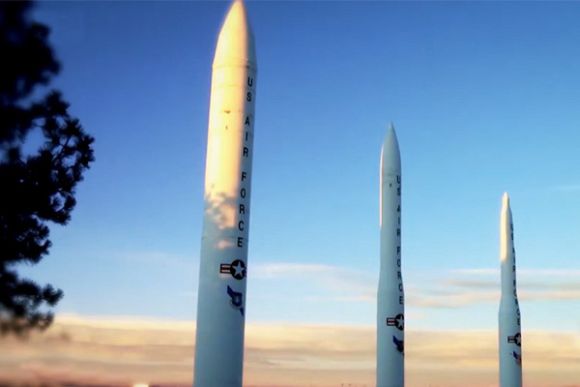Possessing few strategic targets for a northern hemisphere conflict, Australia would only suffer the after-effects of a nuclear war. Dr Norm Sanders breaks down why we're relatively safe.
ON 24 JANUARY 2023, the Bulletin of the Atomic Scientists set the hands of the “Doomsday Clock” at 90 seconds to midnight. It cited the ‘unprecedented danger of the Russia-Ukraine war’ as the reason the clock was set closer to midnight than ever before.
A press release states:
‘...Russia’s thinly veiled threats to use nuclear weapons remind the world that escalation of the conflict – by accident, intention, or miscalculation – is a terrible risk. The possibility that the conflict could spin out of anyone’s control remains high.’
China's continuing stated intentions to invade Taiwan are also cause for concern, with the possibility of nuclear confrontation with the U.S.
During the Cuban Missile Crisis in 1962, I spent a tense hour in the basement of UCLA's Kerckhoff Hall hanging on the radio for news. We all knew that we could be dead in 30 minutes if the Russian ship was sunk and the Russians retaliated with ICBMs as they had threatened to do. Los Angeles is a prime target area. I was more aware of this than most because I funded my graduate studies by working as an engineer at Collins Radio and later at Aerojet General Corporation where we were developing terminal guidance systems for ICBMs. Part of my job was to examine air photos of Russian cities for potential targets.
President John F Kennedy stood eye to eye with Soviet leader Nikita Khrushchev and Khrushchev blinked. War was averted, but I didn't want to go through that again and started making plans to emigrate to Australia when I finished my Master's degree. I was also becoming increasingly uneasy about working with nuclear missiles. I got a Fulbright Fellowship to study at the University of Tasmania.
I never knew until much later how close I and many others came to being incinerated. On 27 October 1962, a group of 11 U.S. Navy destroyers and the aircraft carrier USS Randolph were tailing the Russian ship. Also in the area were four Foxtrot class Russian submarines armed with nuclear torpedoes. One of them, the B-39, had been detected and the Navy dropped depth charges to signal it to come to the surface. Since the B-39 couldn't pick up radio transmissions from Russia while submerged, it had lost contact for a long period.
The captain of the submarine decided that war must already have started and intended to launch nuclear torpedoes at the U.S. ships. But he couldn't make that decision on his own because the approval of three officers on board the B-39 was needed. The captain and the political officer wanted to fire the torpedoes but the executive officer, Vasily Arkhipov, would not agree and the torpedoes stayed in their tubes.
Never heard of Vasily Arkhipov? If he hadn't stood his ground, you might not be reading this.
Noted historian, Arthur M Schlesinger Jr, stated:
“This was not only the most dangerous moment of the Cold War. It was the most dangerous moment in human history.”
So we are still here, but am I now safe in my adopted home? Can Australia really avoid being affected by northern hemisphere nuclear conflicts? The cities themselves are probably not being targeted. Bombing them would have little strategic value for either Russia or China. The Australian intelligence community no doubt has an opinion on this but it doesn't send out many press releases.
The most obvious Australian targets are the U.S. bases. Top of the list is the U.S. facility at Pine Gap, the highly secret U.S.-Australian military installation near Alice Springs. It serves as a major hub for U.S. global intelligence interception and for satellite surveillance operations for military and nuclear missile threats in the region.
Paul Dibb, emeritus professor at the Australian National University and former director of Australia’s Joint Intelligence Organisation, said:
“We need to plan on the basis that Pine Gap continues to be a nuclear target, and not only for Russia. If China attacks Taiwan, Pine Gap is likely to be heavily involved. We need to remember that Pine Gap is a fundamentally important element in U.S. war fighting and deterrence of conflict.”
(For a more detailed account of Pine Gap's capabilities, see my article ‘Pine Gap is still there — bigger and badder than ever’.)
Of course, Pine Gap will have a comprehensive missile defence system. No information has been publicly released, but having a look at the options available can give a clue. Close in, the Terminal High Altitude Area Defense (THAAD) might be deployed. This is an anti-ballistic missile defence system designed to shoot down short, medium and intermediate-range ballistic missiles in their terminal phase. The operational range is 200 kilometres. (The U.S. Navy uses the same type of system under the name of Aegis which is part of the missile defence for Washington DC.)
When North Korea started launching missiles towards Japan, THAAD batteries were quickly deployed in South Korea. The much more familiar Patriots might also ring the facility, but the Patriot PAC-3 MSE has only a 60-kilometre range.
The U.S. relies on the Ground-Based Midcourse Defense system (GMD) to destroy missiles further away from the target, while they are outside the Earth's atmosphere. There are presently a total of 44 GMD systems deployed, 40 at Fort Greely, Alaska and four at Vandenberg Space Force Base in California. Given the importance of Pine Gap, there might be an unannounced GMD system in place somewhere to the north of Australia.
Compared to the number of missiles that China and Russia have, a few GMD systems won't give much protection. China already has 400 nuclear weapons with plans for 800 more. Russia has 5,977, slightly more than the USA's 5,428. Of these, Russia has 1,588 deployed and ready to launch and the U.S. has 1,644.
Of course, ICBMs are just part of the nightmare. Cruise missiles like those pounding Ukraine can also be nuclear armed with smaller warheads. They can be launched from the ground, ships, submarines and planes. And not only from warplanes. The U.S. has developed a system called Rapid Dragon, the roll-on, roll-off system that allows the launch of multiple AGM-158 JASSM cruise missiles using standard airdrop procedures from the open cargo bay door at the rear of transport aircraft.
Upon release, the weapon deploys its control surfaces and heads to a target as far as 1,900 kilometres distant. The system essentially transforms a regular transport aircraft into a strike platform with the capability of dropping a swarm of 45 missiles at a time — a challenge for any defence. The Chinese are developing a similar system and they have just the aircraft to carry it — the Xi'an Y-20: a four-engined, rear loading cargo plane with a range of 4,500 kilometres.
Next on the target list is the Naval Communication Station Harold E Holt facility at Northwest Cape, near Exmouth in northwest West Australia. The base is a vital link in communicating with America's large fleet of ballistic missile-equipped nuclear submarines.
The station is operated and maintained by the Australian Department of Defence on behalf of Australia and the United States and provides Very Low Frequency (VLF) radio transmission to U.S. Navy, Royal Australian Navy and allied ships and submarines in the western Pacific Ocean and eastern Indian Ocean.
The attraction of VLF frequencies is their long range, high reliability and the prediction that in a nuclear war, VLF communications will be less disrupted by nuclear explosions than higher frequencies. For submarines, the big advantage of VLF is its ability to penetrate seawater to a depth of about 30.5 metres so that the sub doesn't have to surface to communicate.
The VLF antennas are large spider webs of wire supported in a top hat arrangement. The centre tower, “Tower Zero”, rises to a height of 387.9 metres. With a transmission power of 1 megawatt, it is the most powerful transmission station in the southern hemisphere. There was some speculation that the emissions from the transmitter caused Qantas Flight 72's “fly-by-wire” electronic systems to make several sudden “pitch-down” maneuvers that resulted in severe injuries on a flight from Singapore to Perth on 7 October 2008. In all, one crew member and 11 passengers suffered serious injuries, while eight crew and 99 passengers suffered minor injuries.
The newest arrival on the target list is RAAF Base Tindal near Katherine in the Northern Territory. The Australian Government announced in February 2020 that $1.1 billion would be spent upgrading the base, including extending the runway and increasing fuel storage. This project followed $500 million of works undertaken so that the base could efficiently operate the Lockheed Martin F-35 Lightning II stealth fighters which are now stationed there.
Modernisation work at RAAF Base Tindal is funded by the U.S. Government and includes an expanded apron with space for six nuclear-capable B-52 bombers. This development has been met with some opposition and concern that their stationing will increase tension with China. The continued upgrading of Tindal is a major counter to Chinese intentions to assert a dominant role in the Indo-Pacific through a war with Taiwan.
A nuclear attack on any of the bases would be devastating in the local area, but less severe at any distance. A number of above-ground nuclear tests were carried out in the 1950s within 105 kilometres of Las Vegas. In 1954, Nevil Shute published a book titled On the Beach, describing a nuclear war creating radiation fallout that killed everything on Earth. The radiation travelled down from the north and had already wiped out Cairns, Brisbane and Sydney.
The book and subsequent films were set in Melbourne, the only major city left. It was claimed that Ava Gardner, one of the stars, famously said Melbourne was “the perfect place to make a film about the end of the world”. In fact, there is only slow atmospheric interchange between hemispheres and radiation would be low by the time it reached Australia.
The big problem would be nuclear winter. A simulation study published in 2019 found that a nuclear war between the United States and Russia would plunge the Earth into a nuclear winter due to the massive amount of smoke and soot released into the atmosphere which would block sunlight. Eventually, it would affect Australia.
The only good news is that research has shown that Australia and New Zealand are among the best places in the world to survive a nuclear apocalypse. Australia scored well as it has a good infrastructure, a huge energy surplus, high health security and abundant food supplies.
That's why I came here in the first place.
Dr Norm Sanders is a former commercial pilot, flight instructor, university professor, Tasmanian State MP and Federal Senator.
Related Articles
- A 'no first use' U.S. nuclear policy could save the world
- 'Big guns' keep the world on nuclear high alert
- Commander of United States Strategic Command wants more nukes
- Uncertainty rife as U.S. exits nuclear disarmament treaty
 This work is licensed under a Creative Commons Attribution-NonCommercial-NoDerivs 3.0 Australia License
This work is licensed under a Creative Commons Attribution-NonCommercial-NoDerivs 3.0 Australia License
Support independent journalism Subscribe to IA.
















